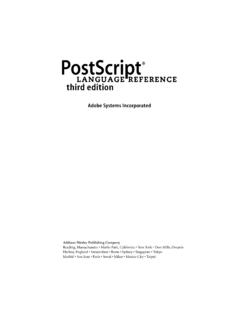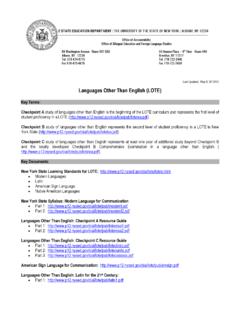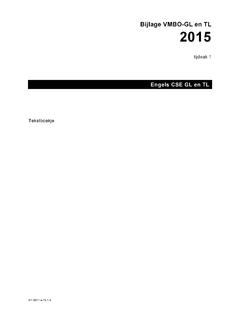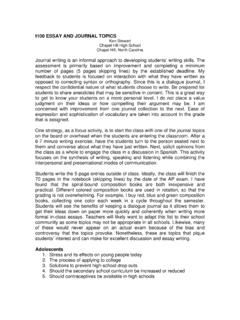Transcription of The National K-12 Foreign Language Enrollment Survey …
1 JUNE 2017. The National K-12. Foreign Language Enrollment Survey report A comprehensive study of Foreign /world Language enrollments across the formal education system, K-12. This report is sponsored by The Language Flagship at the Defense Language and National Security Education Office (DLNSEO), conducted and published by American Councils for International Education in partnership with the American Council on the Teaching of Foreign Languages (ACTFL), the Center for Applied Linguistics (CAL), and the Modern Language Association (MLA), and in collaboration with the National Council of State Supervisors for Languages (NCSSFL). AMERICAN COUNCILS. RESEARCH CENTER. ARC. This report is sponsored by The Language Flagship at the Defense Language and National Security Education Office (DLNSEO), conducted and published by American Councils for International Education in partnership with the American Council on the Teaching of Foreign Languages (ACTFL), the Center for Applied Linguistics (CAL), and the Modern Language Association (MLA), and in collaboration with the National Council of State Supervisors for Languages (NCSSFL).
2 The Institute of International Education (IIE) administered the DLNSEO grant in cooperation with Bryn Mawr College. The Survey data and report do not necessarily reflect the position or policy of IIE or the Government; and no official IIE or Government endorsement should be inferred. 2017 by American Councils for International Education All rights reserved. This publication available online at Table of Contents 5 Description 5 Background 5 History 6 Foreign Language Enrollment 9 High School Foreign Language Programs by State 11 Distribution of High School Programs by State 11 Distribution of High School Programs 16 Anticipated Change in High School Foreign Language Programs 16 Distribution of Less Commonly Taught Languages (LCTLs) High School Programs by State 28 Primary Language Education (K-8).
3 34 Implications 36 Appendix 1: Outreach Campaign 39 Appendix 2: Methodology 45 Challenges 45 Limitations of the K-8 Survey 46 Foreign Languages High School Questionnaire 50 Foreign Languages State Questionnaire List of Tables 7 Table 1. State Foreign Language Enrollment (2014-15). 8 Table 2. Enrollment for Major Languages by State 9 Table 3. Total Number of High School Language Programs Reported in State 11 Table 4. Distribution of Foreign Language Programs 12 Table 5. Type of Class 13 Table 6. Type of Programs 14 Table 7. Type of Collaboration With Other Institutions 15 Table 8. Advanced Placement/International Baccalaureate Courses 15 Table 9. Instruments Used to Assess Student Proficiency 16 Table 10.
4 Anticipated Change in Language Courses Offered 28 Table 11. Schools Offering Language by State; Schools Offering K-8 Instruction 29 Table 12. Languages Offered by Grade Level 30 Table 13. Number of Students per Language K-8. 31 Table 14. Type of Instruction Offered by Language Programs Offered at K-8 Level 32 Table 15. When Classes Are Offered by Language - Programs Offering Grades K-8. Only 33 Table 16. Collaborations by Language , Grades K-8. 33 Table 17. Projected Program Changes by Language 33 Table 18. Assessments Used by Language , Grades K-8. 34 Table 19. IB Offered by Language , All Grade Levels 41 Table Frequency of High Schools by State Based on High School Data File: Sample List Used for HS Census 2015.
5 44 Table Choice of Regression Model by Information Criteria 44 Table Demographic Model of Foreign Language Enrollment Description The current study is the result of a partnership among the following organizations: American Councils for International Education (AC); American Council on the Teaching of Foreign Languages (ACTFL); Center for Applied Linguistics (CAL);. Modern Language Association (MLA); and in collaboration with the National Councils for State Supervisors for Foreign Languages (NCSSFL). Each organization had a specific role to play: American Councils coordinated the effort, conducted an outreach effort to the Language education community as well as a census of all high schools, participated in state level data collection, developed data dissemination tools, drafted the final report and maintains the Enrollment Survey website; engaged its member networks and considerable PR systems to publicize the Survey , consulted on questionnaire design, and participated in state level data collection.
6 ACTFL reached out directly to its membership, inviting all members to promote the Enrollment Survey within their respective organizations and to submit relevant data on Foreign /world Language education. In addition, ACTFL and American Councils have and continue to work collaboratively with NCSSFL to invite and urge state supervisors to submit Enrollment data for their states. The Board of National Council of State Supervisors for Languages (NCSSFL) endorsed this data collection effort and encouraged its membership to contribute data as available. CAL conducted the K-8 portion of the study; MLA made their data on Language enrollments in higher education available for incorporation into the study. Accordingly, this effort constitutes the first comprehensive study of Foreign /.
7 World Language enrollments across the formal education system, K-16. The study was commissioned by the NSEP through the Institute of International Education (IIE). One of its purposes was to provide insight into strategic planning for the Flagship Language Program of the National Security Education Program. Background Education in Foreign languages in the , particularly at the K-12 level, continues to experience dynamic changes in terms of numbers and locations of programs and program designs. A number of states are involved in major efforts to support offerings of K-12 Language education while locally, decisions are being taken to eliminate or consolidate programs in specific languages. Recent evidence points to a renewed interest in Language immersion, particularly dual Language immersion, as a way to more effectively incorporate second Language learning into the curriculum for native and non-native speakers of English.
8 It is therefore important to map and document such developments at the K-12 level on a timely basis in order to ensure that stakeholders, managers, and policy makers at all levels of the educational system remain well informed about the need for second Language learning and are fully empowered to address issues that may arise. History The absence of comprehensive Enrollment data on Foreign Language education in the seriously impedes systematic assessment of National capacity in languages and the development of effective policies and essential planning for the internationalization of education more generally. Periodic Enrollment studies, particularly those undertaken since the 1960s by the Modern Language Association (MLA), provide a representative view of Language enrollments in higher education.
9 But the lack of consistent parallel efforts at the K-12 level seriously complicates the analysis of local or National trends, particularly at a time of significant demographic shifts in the population and a resurgence of interest in Foreign Language instruction in many school districts around the country. Sponsored by the National Security Education Program/The Language Flagship in 2009, American Councils developed the first National Survey of Less Commonly Taught Language Instruction in High Schools (grades 9-12). The Survey identified high schools offering instruction in Flagship-related languages and collected basic data on Language instruction in order to support ongoing efforts to strengthen critical Foreign Language education.
10 During 2007-08, ACTFL conducted a National Foreign Language Enrollment Survey of K 12 Public Schools to investigate the status of Foreign Language Enrollment . This was a three-year project, part of a Department of Education grant, to provide more detailed and accurate information on K-12 Foreign Language Enrollment and to investigate changes in Foreign The National K-16 Foreign Language Enrollment Survey report 5. Language Enrollment since previous data collection efforts over the 2004-05 academic year. In 2008, with funding from the Department of Education's International Research and Studies Program, CAL conducted a Nationwide Survey of Elementary and Secondary Schools to collect detailed information on Foreign Language education in the United States.






